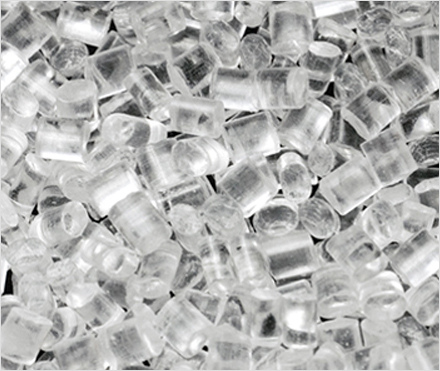ATPolymer is a professional cross linked polyethylene manufacturer. XLPE is the abbreviation of the English name of cross-linked polyethylene. Polyethylene is a linear molecular structure that is easily deformed at high temperatures. The process of cross-linking polyethylene turns it into a network structure. This structure is highly resistant to deformation even at high temperatures.

Cross-linked polyethylene is an advanced form of polyethylene that has been chemically or physically modified to create bonds between its polymer chains, significantly enhancing its properties. This material boasts increased durability, superior thermal stability, and excellent chemical resistance while maintaining flexibility. These attributes make XLPE a preferred choice in various applications, such as plumbing, where it is used for both hot and cold water systems due to its resistance to scaling and corrosion. It's also favored in radiant floor heating systems and medical tubing, thanks to its ability to handle high temperatures and withstand harsh chemicals. Additionally, XLPE finds use in electrical insulation and automotive components, where its robustness and flexibility are crucial. Despite being more expensive than regular polyethylene, its long-term performance benefits make it an invaluable material in many industries.
1. Enhanced Heat Resistance
The cross-linked polyethylene structure of XLPE allows it to withstand higher temperatures than standard polyethylene, typically up to 90°C continuously and 130°C intermittently. This makes XLPE cross-linked polyethylene ideal for high-temperature environments like power cables and industrial machinery.
2. Improved Mechanical Strength
Cross-linked polyethylene XLPE provides superior tensile strength and resistance to abrasion compared to standard polyethylene. The cross-linked polyethylene structure enhances its durability, making it an excellent choice for applications requiring resistance to physical stress, cuts, and impacts.
3. Superior Electrical Insulation
XLPE offers excellent electrical insulation, ensuring minimal risk of electrical leakage. This makes XLPE cross-linked polyethylene ideal for power distribution, high-voltage systems, and telecommunications, providing reliable, safe, and efficient electrical performance.
4. Chemical Resistance
Cross-linked polyethylene XLPE exhibits exceptional resistance to oils, solvents, and harsh chemicals. This makes it suitable for environments like chemical plants and refineries, where cross linked polyethylene cable or pipes are exposed to aggressive substances without degrading.
Electrical Engineering
XLPE, procured from ATPolymer cross-linked polyethylene supplier, is favored for high-voltage cables due to its superior insulation properties derived from its cross-linked polyethylene structure.
The cross-linked structure enhances the material's ability to withstand high electrical stresses and ensures efficient transmission of electricity over long distances.
XLPE cables exhibit excellent resistance to heat, reducing the risk of overheating and electrical failures, thus ensuring reliable power transmission.
Automotive Sector Utilization
XLPE is extensively used in wire and cable harnesses in automobiles, benefiting from its robust mechanical properties.
The cross-linked polyethylene structure imparts high tensile strength to XLPE, making it suitable for withstanding the mechanical stresses and vibrations experienced in automotive applications.
Additionally, XLPE cables exhibit resistance to abrasion, ensuring long-term reliability and durability in the demanding automotive environment.
Construction Industry
XLPE is commonly employed in the construction of pipes for transporting natural gas and water.
Its cross-linked structure provides enhanced durability and resistance to chemical corrosion, ensuring the longevity and integrity of the infrastructure.
XLPE pipes are preferred for their ability to withstand harsh environmental conditions and aggressive substances, making them suitable for a wide range of construction projects.
Building Insulation Purposes
XLPE is utilized in the manufacturing of foam insulation boards for thermal insulation in buildings.
The material's excellent thermal properties, coupled with its structural integrity derived from cross-linking, make it an effective insulating material.
XLPE foam insulation boards contribute to energy efficiency by minimizing heat loss or gain in buildings, thereby reducing heating and cooling costs.
1. Specialized in XLPE Manufacturing
ATP Polymer is a leading cross-linked polyethylene manufacturer, specializing in the production of high-quality Cross-Linked Polyethylene (XLPE) materials. Their annual design capacity of nearly 12,000 tons enables them to efficiently meet the demands of industries such as electrical, automotive, and construction.
2. Wide Range of Applications
ATP Polymer's cross-linked polyethylene XLPE is widely used in power cables, telecommunications cables, pipes, and insulation materials, offering excellent electrical, heat, and chemical resistance. As a cross-linked polyethylene manufacturer, they can scale production to meet diverse industry needs thanks to their robust design capacity.
3. Quality Assurance
ATP Polymer ensures all products undergo rigorous quality control. Their quality control ability fully meets the requirements of ISO9001:14001, ensuring that every batch of XLPE material maintains consistent performance, safety, and reliability.
4. Customization Capabilities
ATP Polymer, a leading cross-linked polyethylene manufacturer, offers tailored solutions based on client specifications. We can accommodate both small and large-scale custom orders, ensuring that customers receive the exact XLPE materials they need.


XLPE cross linked polyethylene has strong acid and alkali resistance and oil resistance. lots combustion products are water and carbon dioxide, which is less harmful to the environment and meets the requirements of modern fire safety.

Cross linked polyethylene XLPE with a net-like three-dimensional structure has excellent heat resistance. lt will not decompose and carbonize below 200℃, the long-term working temperature can reach 90 ℃, and the thermal life can reach 40 years.

XLPE maintains the original good insulation properties of PE, and the insulation resistance is further increased. Its dielectric loss tangent value is very small, and it is tiny affected by temperature.

Due to the establishment of new chemical bonds between macromolecules, the hardness, stiffness, wear-resistance, and impact resistance of XLPE are improved, which makes up for the shortcomings of PE that is susceptible to environmental stress and cracking.
The XLPE material is an excellent insulator because of its strong dielectric properties, high resistance to heat, moisture, and chemicals. The cross-linking process improves its mechanical strength, making it durable and resistant to stress cracking. These characteristics make XLPE ideal for use in power transmission and distribution cables.


XLPE improves cable performance by providing better insulation, allowing cables to operate at higher temperatures without degrading. Its cross-linked structure also gives the material greater resistance to mechanical stress, chemical exposure, and environmental factors, reducing the risk of cable failure and enhancing the lifespan and reliability of electrical systems.


Yes, we offer custom XLPE products tailored to specific requirements. ATP Polymer can modify the design, size, and other properties of XLPE materials to meet your needs for various applications, including power cables, insulation, and industrial systems, ensuring optimal performance.

